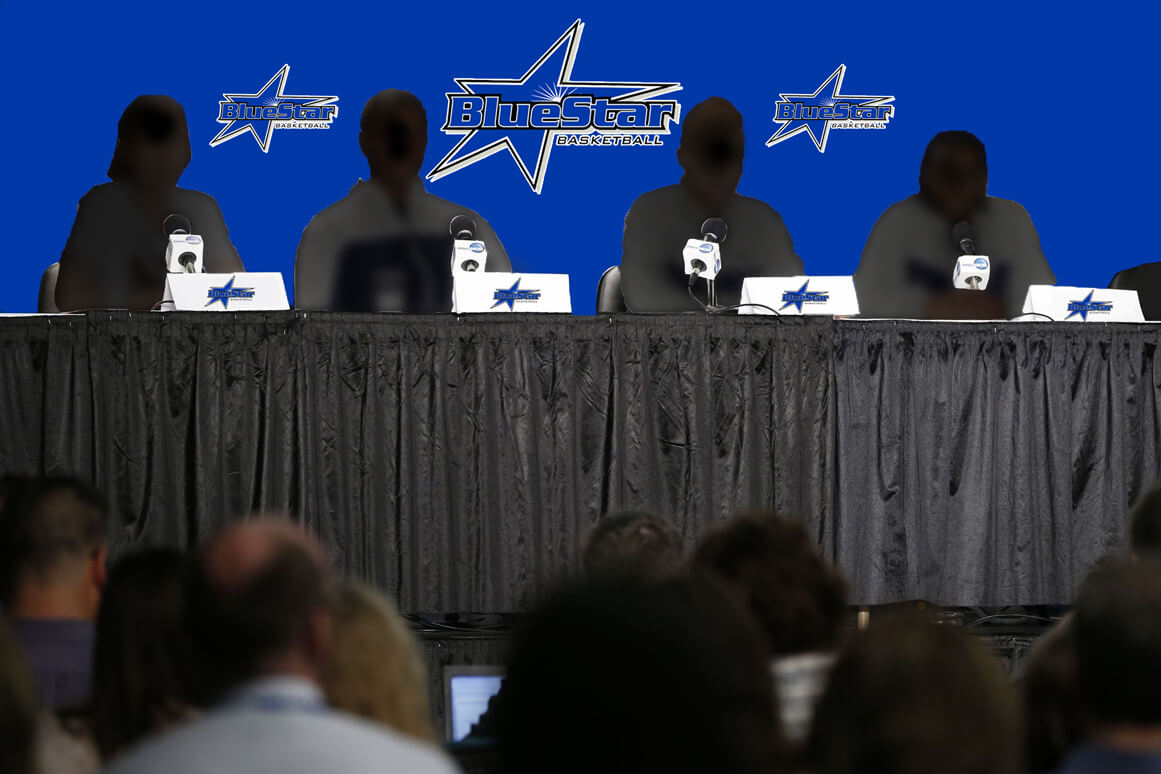It’s women’s basketball’s version of “Same Time, Next Year.”
UConn blows an NCAA Tournament opponent to smithereens.
A knuckle-headed instant “hot take” from a mainstream media representative who otherwise doesn’t write much about the sport declares that such a result isn’t good for a sport he never covers.
An array of individuals within the sport, or those professing to care about the sport but with little to no working knowledge of how the commercial media actually functions, defensively tee off on said knuckle-head with “hot takes” of their own, rehashing sweeping damn-the-media indictments about an industry they fundamentally (and willfully) misunderstand.
A social media pile-on ensues, with a leading college basketball analyst who doesn’t actually analyze the sport (but used to, when he was learning how to be an analyst) opining that “the problem is us.” Said analyst doesn’t explain who “us” is supposed to be, or why “us” is (are?) a problem. Or what can be done about it, because hey, he’s “gotta go to work.”
Another “hot take” elsewhere comes to the defense of the original “hot take” writer, and you won’t believe what happens next!
More nail-spitting from a coach who’s terrific at what what she does in her profession but who could make a more concerted effort to learn how mine works. This is the same coach who recently roasted a media figure in her community sympathetic to her concerns. He just got hired by a sports start-up that’s barely pushed the launch button, but she demanded to know why his new outfit isn’t covering her out-of-season team instead of one that’s at, say, spring training.
For some of us who care about the sport and have actually covered it for some time, and realize there are kernels of truth in all of these arguments, it’s saddening and maddening.
I want to call bullshit on all of this, because that’s what it is.
Pardon my language, but after nearly 30 years of hearing these tiresome talking points all the way around, enough is enough.
Enough with blaming UConn for supposedly being bad for the sport.
Enough with blaming men in sports media for the supposed lack of women’s sports coverage.
None of these things are true. They are utter bullshit.
More than anything, enough with the bullshit posturing on social media, where easy outrage, politically correct virtue-signaling and mob silencing tactics abound. I would imagine as soon as I push the button on this, a good bit of it will be headed my way. So be it.
It has happened before, from people who know precious little about what I’ve actually covered and observed as coverage of women’s sports has grown in the last two decades, but who insist they do.
Their “hot takes” substitute for actual years of cultivating beats, speaking to individuals across a broad spectrum of the women’s sports landscape, covering games and seasons and absorbing one of the more fascinating developments in American sports.
I’ve been lucky enough to have a seat at the table during this time, and this is why what is happening now is so unfortunate. All to score stupid, fleeting social media brownie points, and to preen before their “enlightened” followers.
That women’s sports, and women’s basketball, have grown so much in my time around them is a phenomenal achievement. I’ve been honored to play a small part, pushing for coverage at my former big-city newspaper as well as other publications that rarely offered it before, and having a respectable amount of success to show for it.
Women’s basketball remains a niche sport, but a healthy one, and there’s nothing wrong with that. That it hasn’t leaped into the mainstream has become a crusade for many in the game who see the sports media as somehow being to blame.
For the record, I know the individual who wrote the piece that got everybody mad. He’s a good journalist with a solid track record in the business. I wish his post would have been longer, and more substantive, because there is a valid point to be made that the casual fans that many in women’s basketball say they want to reach will not look past the score any more than he did.
My message here is to those people in women’s basketball who are frustrated, angered and dismayed by this kind of media treatment, especially when they see so much more coverage for men’s sports, after all these years:
I get where you’re coming from. Even if you may not like what I’m about to write, please try to understand where I’m coming from.
Gender bogeymen
Don’t fall for the bullshit from people who have never been in the industry that the overwhelming maleness of sports departments is the problem.
While I’ve had to blast through some walls of resistance that were plastered with gender bias, men in this industry have been some of my biggest champions in covering women’s basketball.
In my former newspaper newsroom, those male editors told me yes more than they ever said no. They gave me space and put me on the expense account, and I traveled the country, covering women’s basketball, women’s soccer and other women’s sports.
It was a man, Mel Greenberg, who started the first women’s basketball poll more than 40 years ago. It was a women’s sports leader, Donna Lopiano, then of the AIAW, who told him she was wary of newspaper coverage that would be similar to that of men’s sports. She didn’t mean it as a compliment.
It was a man, Mike Flynn, who started this site several years ago, just months after I left the newspaper business, one that he had been in. We huddled in Philly for several days to figure out a new path to cover the sport and give writers like me, Mel, Dick Weiss and others a place to keep writing, even if we we had to find new ways to make a living.
It was a man, Larry Donald, who took a flier on me in 1991, giving me, an unknown, a shot to write about women’s basketball at Basketball Times. It was another man, John Akers, the current publisher of the magazine, who left the light on for me for many years, until I called time on that gig last fall, after 26 terrific years.
It was a man, Mike Douchant, who asked me 20 years ago to contribute to a college basketball encyclopedia he was editing, and that was to be published by Inside Sports magazine. I wrote a history of the women’s game and included stats of leading players and coaches. In a contributors’ thumbnail, Mike wrote that I helped him “shed his basketball chauvinism.”
It’s one of the most touching compliments I’ve ever received, and I cherish it today.
Too many of the few women in my industry have dodged covering women’s sports like the plague. They didn’t want to be pigeon-holed, and wanted to be on a proper career path of promotion and prominence. I never begrudged them that, but it belies the “women helping women” sisterhood nonsense that pervades too much of our society. It’s a myth as much as it is an aspiration.
Don’t worry about blowhards who want to blast UConn. They’re not worth the bother. The same outlet that posted what ticked you off also published this a couple days later, and many of you were absolutely swooning over the story. For good reason.
Don’t get so personally offended every time someone in the media, or especially on Twitter, says he (and there are women who feel this way too) doesn’t like women’s basketball. It’s all right if they don’t. They’re not necessarily sexist if they don’t.
Who cares if they don’t? Care about the fans you’ve got and work to win over more. They are out there, and you don’t need the media coverage you think to reach them.
Most of all, if you want more and better media coverage, don’t browbeat those friendly forces in the industry who have more pressing obligations or who have different ideas than you to achieve the same ends. IN ALL CAPS.
Media fallout
That many of you believe it is the commercial media’s duty to help you do this needs to be dispensed with. Those of us who are (or who have been) employed by media outlets do the job that our superiors tell us to do, not the one that meets your ideals of gender equality.
I don’t mean to sound so harsh, but as I wrote a few years ago, there is no Title IX for media, nor should there be.
Over the last decade, many thousands of us have lost our jobs because traditional media organizations have been cratering financially. Those jobs are not coming back, and those outlets are drastically having to change to stay in business.
Mainstream media outlets are under more pressure than ever to deliver web clicks, ratings and other metrics to potential advertisers. They need to reach mass audiences, because this is how their business models are drawn, for better or for worse, and it’s more bottom-line than ever.
Women’s basketball does not have a mass audience, and it is a fallacy to think if there was more coverage, there would automatically be more interest. It simply does not work this way. Unlike coaches, “hot take” artists and others, I have actually put this theory to the test, and it’s not as easy as that.
Media coverage reflects interest more than it drives it. The UConn media contingent didn’t pay much attention when Geno Auriemma arrived in 1985, sporting a different hairline and sweater vests, having inherited a losing program and a tiny gym.
Those writers, and their outlets, covered the team sporadically at first as UConn began to win, and reach the NCAAs and start pulling in bigger crowds. The coverage certainly helped, but the explosion occurred in a grassroots, bottom-up fashion, over some years, followed by national championships and ESPN.
After a couple of decades of thinking television exposure and national mainstream media coverage was going to deliver the magic bullet for women’s basketball, we’re seeing that it’s not that simple. The NCAA’s decision to let ESPN dictate starting times was disastrous for many of us writing for newspapers.
I missed a few deadlines, or had to work around them, at a detriment to our readers, especially since I covered a Georgia team that was often sent out to the West in the NCAA tourney: Missoula, Portland, Seattle. Great places to visit, hellish to write from to make the final edition. This made the decisions of many newspapers not to send writers at all very easy, especially as the bottom began to drop out of my business.
Grassroots roots
Flat TV ratings and attendance prompted the NCAA to commission Val Ackerman to conduct her 2013 white paper, and it’s instructive to look back on it five years later. The WBCA created working groups to tackle issues in promoting the game, and from that came a brilliant grassroots marketing seminar that needs to be heeded even more today.
This is how I see the sport best being promoted, at the grassroots level, including media coverage. Look at what Mississippi State has done in a place where there aren’t many big cities. If it can be done in Starkvegas, it can be done anywhere.
Don’t get me wrong. What ESPN has done on balance for the women’s game has been fantastic. TV games are great, but not when they’re panning empty arenas in March.
Pay less attention to what national outlets aren’t covering women’s basketball and pay more attention to who owns your local media outlets. The chances are they’ve been been scarfed up by an out-of-town chain or hedge fund that immediately lays off staff and strip-mines what’s left of the business, valued typically in real estate terms.
If that coverage vanishes-and trust me, local news is in grave danger everywhere-that’s much more devastating to you and your team than USA Today indulging in an ill-advised “hot take” every now and then.
Too many people in this sport forgot about the grassroots appeal of the game that I found genuine and authentic when I came on the scene in the early 1990s.
There’s never been a better time to be a fan of women’s basketball, because there’s never been more and better coverage of women’s basketball. It’s light years ahead of when I started. Comparisons to the percentages of coverage the men receive is exactly the wrong way to look at it.
Like minor league baseball, soccer and many other non-revenue college sports, women’s basketball has a chance to connect with fans disaffected with the sports, and the sports figures, who are in the mainstream eye that many of you envy.
Be careful what you wish for.
Wendy Parker is a sportswriter and web editor who has covered women's basketball since the early 1990s. She is a correspondent for Basketball Times and formerly covered women's and college sports, soccer and the Olympics at The Atlanta Journal-Constitution. She is the author of "Beyond Title IX: The Cultural Laments of Women's Sports," available on Amazon, and the creator of Sports Biblio, a blog about sports books and history.




